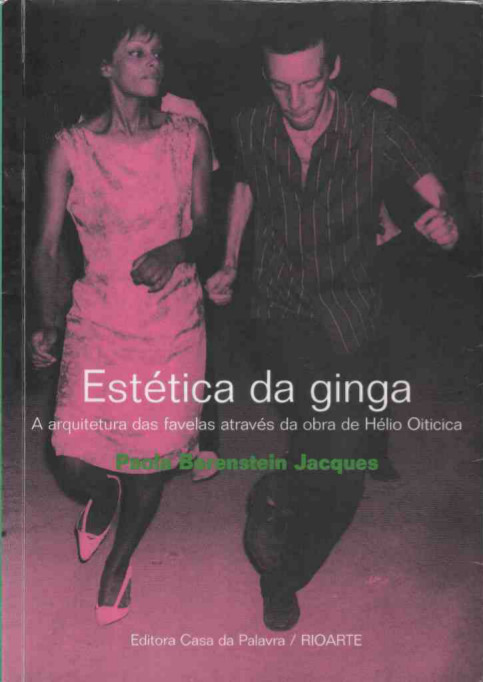Paola Berenstein Jacques: Estética da ginga: A arquitetura das favelas através da obra de Hélio Oiticica (2001) [Portuguese]
Filed under book | Tags: · architecture, art, brazil, city, favela, neo-concrete art, philosophy, tropicalia, urbanism

Estética da ginga goes from a transcendental gesture [the rising of the artist, Hélio Oiticica, to favela’s hill] to perform a mapping in three fields: artistic, architectural and, by extension, the sociocultural.
The book pursues an interdisciplinary frontier, narrowing notions of art, architecture and philosophy.
The life and work of Hélio Oiticica serve as a living model for this aesthetic in which the “ginga”, dancing, covering and uncovering his body of dancer, artist, slum inhabitant, the artist evokes at the same time the samba of the “favelas”, the “favelas” themselves, and shows us that the origin of the artwork changes every moment in the life of a city, a group, a man, in a sort of ephemeral joy.
Publisher Casa da Palavra, Rio de Janeiro, 2001
ISBN 8587220438
160 pages
via Andreia Costa
PDF (no OCR)
Comment (0)Doreen Massey: For Space (2005)
Filed under book | Tags: · architecture, city, geography, globalisation, neoliberalism, place, politics, space, time

“In this book, Doreen Massey makes an impassioned argument for revitalising our imagination of space. She takes on some well-established assumptions from philosophy, and some familiar ways of characterising the twenty-first century world, and shows how they restrain our understanding of both the challenge and the potential of space.
The way we think about space matters. It inflects our understandings of the world, our attitudes to others, our politics. It affects, for instance, the way we understand globalisation, the way we approach cities, the way we develop, and practice, a sense of place. If time is the dimension of change then space is the dimension of the social: the contemporaneous co-existence of others. That is its challenge, and one that has been persistently evaded. For Space pursues its argument through philosophical and theoretical engagement, and through telling personal and political reflection. Doreen Massey asks questions such as how best to characterise these so-called spatial times, how it is that implicit spatial assumptions inflect our politics, and how we might develop a responsibility for place beyond place.
This book is “for space” in that it argues for a reinvigoration of the spatiality of our implicit cosmologies. For Space is essential reading for anyone interested in space and the spatial turn in the social sciences and humanities. Serious, and sometimes irreverent, it is a compelling manifesto: for re-imagining spaces for these times and facing up to their challenge.”
Publisher Sage, 2005
ISBN 1412903610, 9781412903615
222 pages
Review: Matthew Sparke (Progress in Human Geography).
Commentary: Ben Anderson.
PDF (no OCR, updated on 2021-1-25)
Comments (2)Owen Hatherley: A New Kind of Bleak: Journeys through Urban Britain (2012)
Filed under book | Tags: · architecture, city, modernism, neoliberalism, united kingdom, urbanism

“The urban state of the nation—from Olympic dreams to broken Britain.
This is what austerity looks like: a nation surviving on the results of what conservatives privately call “the progressive nonsense” of the Big Society agenda.
In a journey that begins and ends in the capital, but takes in Belfast, Aberdeen, Plymouth and Brighton, Hatherley explores modern Britain’s urban landscape and finds a short-sighted disarray of empty buildings, malls and glass towers. Yet while A New Kind of Bleak anatomizes “broken Britain,” Hatherley also looks to a hopeful future and discovers fragments of what it might look like.”
Illustrated by Laura Oldfield Ford, author and artist of Savage Messiah.
Publisher Verso Books, 2012
ISBN 1844679098, 9781844679096
640 pages
review (Andy Beckett, The Guardian)
review (Sarah Morrison, The Independent)
review (Igor Toronyi-Lalic, The Telegraph)

